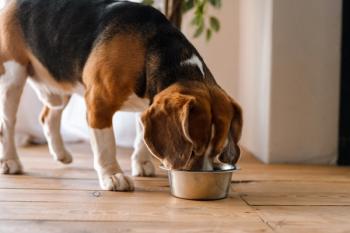
Calculate the perfect portions for pets
Are Fluffy and Spot eating too much or too little? Use this step-by-step guide to determine caloric requirements for your veterinary patients.
Getty ImagesHow do you know if Fluffy and Spot are eating too much or too little?
The first step is to determine the patient's resting energy requirement (RER). RER is a function of metabolic body size and represents the energy requirement of the patient while at rest at a controlled temperature.
Here's one simple formula determining RER for medium-sized patients (i.e., pets weighing between 2 and 45 kg):
30 x (body weight in kilograms) + 70 = RER for medium-sized patients
So if Spot weighs 44 pounds (or 20 kg), the equation would look like:
30 x 20 kg + 70 = 670
Spot's RER is thus 670 kcal per day.
Getty ImagesThough this formula is generally adequate for medium-sized patients, it may not be accurate for small (less than 2 kg) or large (more than 45 kg) patients. For these sizes, use:
70 x body weight in kilograms to the ¾ power = RER for small/large patients
For example, if Tiny weighs 3 pounds (or 1.36 kg) and we use the formula for medium-sized dogs, Tiny's RER calculates to 111 kcal per day.
30 x 1.36 kg + 70 = 111 kcal/day
But if we use the formula for small and large dogs, Tiny's RER is only 88 kcal per day-almost 23 kcal less than the first, less accurate calculation.
70 x (1.36 kg)3⁄4 = 88 kcal/day
The next step is to calculate the patient's Daily Energy Requirement (DER). DER is calculated by multiplying the patient's RER by a coefficient based on life stage and body condition. Common coefficients are listed below:
Using the chart above, if Tiny from the previous example is a kitten, we would calculate its DER as follows:
2.5 x 88 kcal/day = 220 kcal/day
It's important to remember that all caloric calculations are estimates of the patient's energy needs-actual caloric requirements may vary. However, these calculations serve as an excellent starting point for every nutritional recommendation.
Feeding instructions
To determine the amount of food the pet should receive, simply divide the patient's DER by the number of calories in a can or cup of the selected food or treat.
If Tiny's DER is 220 kcal/day, and dry kitten food “X” contains 523 kcal/cup:
220 kcal / 523 kcal per cup = 0.4 cups of food per day
This amount may be divided by the number of feedings the patient will receive. Remember to be specific in your instructions to your client. Include the name and brand of the food you are recommending, the number of feedings per day, the amount to be fed per day and per feeding, the number of treats included, and when the plan may change.
Ed Carlson, CVT, VTS (Nutrition), is the technician learning and development manager at InTown Veterinary Group.
Newsletter
From exam room tips to practice management insights, get trusted veterinary news delivered straight to your inbox—subscribe to dvm360.




